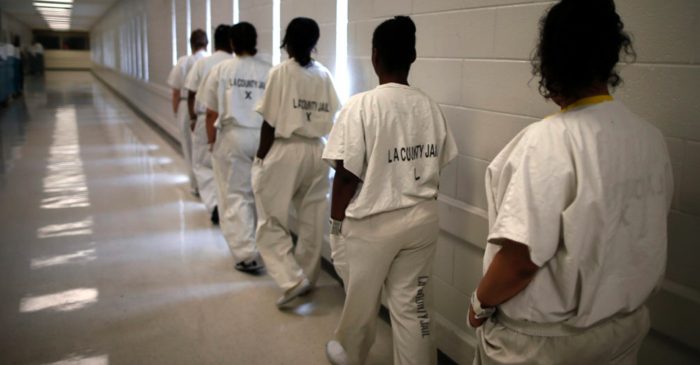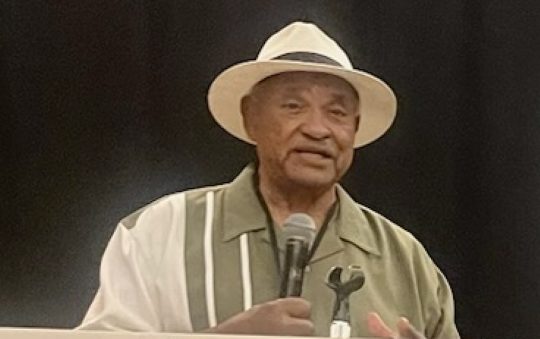Courtesy The Marshall Project/PBS
Although the number of people in prisons and jails in America has slightly declined, numbers released on Thursday, April 25, by the Bureau of Justice Statistics still show that nearly 1.5 million individuals were in prison by the end of 2017.
The statistics also note that the U.S. continues to lock up more people than any other nation. And, despite a narrowing disparity between incarcerated black and white women, females have emerged as the new face of mass incarceration.
“I don’t think this should be much of a surprise as two of the main for-profit prison companies were founded around the same time,” said Ron Stefanski, whose website prisoninsight.com, works to hold prisons accountable for the treatment of current, former and future inmates.
“When these for-profit companies were created, they found a way to generate revenue off of inmates and this led to a huge influx of prisoners, both male and female,” Stefanski said.
In 2000, black women were incarcerated at six times the rate of white women, but in 2017, black women were imprisoned at less than double the rate of white women, according to the latest information.
The number of white women in prison has increased by more than 40 percent since 2000 while the number of black women incarcerated has fallen by nearly 50 percent.
The most recent report from the Prison Policy Initiative revealed that, looking at the big picture shows that a staggering number of women who are incarcerated are not even convicted with one quarter of the women behind bars having not yet gone to trial.
Sixty-percent of women under the control of local authorities have not been convicted of a crime and adding to the picture of women in local jails, aside from women under local jurisdictions, state and federal agencies pay local jails to house an additional 13,000 women, according to the Prison Policy Initiative.
For example, ICE and the U.S. Marshals, which have fewer dedicated facilities for their detainees, contract with local jails to hold roughly 5,000 women – so the number of women physically held in jails is even higher.
According to the Prison Policy Initiative, avoiding pre-trial incarceration is uniquely challenging for women.
The number of un-convicted women stuck in jail is surely not because courts are considering women, who are generally the primary caregivers of children, to be a flight risk, according to the Prison Policy Initiative report.
The far more likely answer is that incarcerated women, who have lower incomes than incarcerated men, have an even harder time affording cash bail.
When the typical bail amounts to a full year’s income for women, it’s no wonder that women are stuck in jail awaiting trial, the report’s author said.
Even once convicted, the system funnels women into jails: About a quarter of convicted incarcerated women are held in jails, compared to about 10 percent of all people incarcerated with a conviction.
Also, while stays in jail are generally shorter than in stays in prison, jails make it harder to stay in touch with family than prisons do.
Phone calls are more expensive, up to $1.50 per minute, and other forms of communication are more restricted – some jails don’t even allow real letters, limiting mail to postcards.
This is especially troubling given that 80 percent of women in jails are mothers, and most of them are primary caretakers of their children.
Thus children are particularly susceptible to the domino effect of burdens placed on incarcerated women, the report’s author said.
Black and American Indian women are markedly overrepresented in prisons and jails, according to the report.
Incarcerated women are 53 percent White, 29 percent Black, 14 percent Hispanic, 2.5 percent American Indian and Alaskan Native, 0.9 percent Asian, and 0.4 percent Native Hawaiian and Pacific Islander.
“While we are a long way away from having data on intersectional impacts of sexuality and race or ethnicity on women’s likelihood of incarceration, it is clear that Black and lesbian or bisexual women are disproportionately subject to incarceration,” Prison Policy Initiative Author Aleks Kajstura said.
Three out of four women under control of any U.S. correctional system are on probation, according to Kajstura.
Probation is often billed as an alternative to incarceration, but instead it is frequently set with unrealistic conditions that undermine its goal of keeping people from being locked up, she wrote for the Prison Policy Initiative.
For example, probation often comes with steep fees, which, like bail, women are in the worst position to afford.
Failing to pay these probation fees is often a violation of probation.
Childcare duties further complicate probation requirements that often include meetings with probation officers, especially for women with no extra money to spend on babysitters or reliable transportation across town.
“All of these issues make women particularly vulnerable to being incarcerated not because they commit crimes, but because they run afoul of one of the burdensome obligations of their probation supervision,” Kajstura said.
Still, she noted in the report that the picture of women’s incarceration is far from complete, and many questions remain about mass incarceration’s unique impact on women.
“Based on our analysis in this report, we know that a quarter of incarcerated women are un-convicted,” she wrote in the report.
Kajstura continued:
“But is that number growing? And how do the harms of that unnecessary incarceration intersect with women’s disproportionate caregiving to impact families?
“Beyond these big picture questions, there are a plethora of detailed data points that are not reported for women by any government agencies, such as the simple number of women incarcerated in U.S. Territories or involuntarily committed to state psychiatric hospitals because of justice system involvement.”








